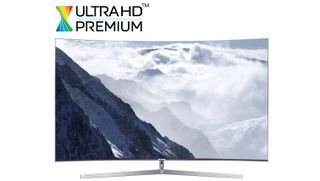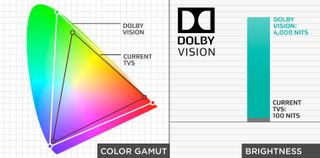The New 4K TV Format War: Read This Before You Buy
2016 could be a breakout year for OLED sets, but a potential format war over HDR looms.

There’s a strong possibility that the brand-new TV you’re about to buy could be obsolete before you can say 4K.
Dozens of television and consumer electronics firms have jumped onto a new television format called "Ultra HD Premium," an update of the 4K ultra-HD standard. Still others are supporting Dolby Vision, a variation on the new ultra-HD format, while other companies like Sony are pushing their own production systems for future 4K programs. Not be outdone, some companies, such as Samsung, continue to tease viewers with next-generation 8K TVs.

The big-screen showdown was in full force at the CES 2016 show in Las Vegas earlier this month. LG demonstrated its next-generation OLED sets, including a 65-inch stunner in the new G6 line that is a tenth of an inch thick, yet delivers a razor-sharp picture. Panasonic and Philips brands also plan to sell 4K OLED sets, as do bargain Chinese TV makers TCL and ChangHong. With more models available, OLED prices are bound to fall.
But the display hardware was overshadowed by scores of companies touting the Ultra HD Premium format.
HDR Wars: Ultra HD Premium vs. Dolby Vision
Why you can trust Tom's Guide
The newly minted Ultra HD Premium specification is courtesy of the UHD Alliance. The industry trade group is trying to standardize high-dynamic-range or HDR 4K ultra-HD sets and players. The actual picture resolution remains the same as 4K (3840 x 2160 pixels), but HDR calls for higher and more-precise brightness levels, expanded color reproduction, and new audio capabilities.
Essentially, HDR delivers a wider color gamut and better contrast to reveal richer color gradations and more detail in shadowy and overly bright portions of an image. The improvement is definitely noticeable, but questions about compatibility, even among forthcoming sets this year, could keep shoppers on the sidelines.

Paul Gray, a principal analyst and researcher at IHS, said it's unclear at the moment how content creators and TV makers will handle the new, premium format and competing Dolby Vision HDR format. The Ultra HD Premium standard, supported by an industry group and dozens of consumer electronics firms, sets a minimum requirement for color and brightness.
MORE: Our Favorite Televisions From 32 Inches and Up
The Dolby Vision goes beyond the Ultra HD Premium standard with a higher color-bit depth. (Having more bits means more possible colors or shades of colors. Ultra HD Premium offers 10-bit color, while Dolby Vision uses 12-bit color.) Gray said it's yet to be determined what will happen when a TV that's only Ultra HD Premium compatible encounters a Dolby Vision movie, for example. The result, essentially a downgraded image, could look less than ideal, skewing colors and brightness levels. (For its part, Dolby says there is a backward-compatible path.)

What is clear is that your existing TV won't be able to handle the new HDR formats, although Sony has said some of its current high-end sets will be upgradable via software.
So as spectacular as some of the coming HDR sets appear, shoppers will encounter a bewildering array of choices.
Samsung and Sony boast that their new 4K sets will be Ultra HD Premium-compatible. LG is bragging about supporting Dolby Vision — and Ultra HD Premium. Also in the Dolby Vision camp is Chinese TV maker TCL. It will add a high-end 65-inch 4K ultra-HD set called the X1this year that will support Dolby Vision.

Moreover, there will be plenty of standard HD sets still in stores this year; no one is killing off that standard yet. Then there will be 4K ultra-HD TVs that support the higher 4K resolution, but not HDR. And then there will be sets that may appear without either Dolby or premium logos, but may be software-upgradable to handle the formats.
MORE: Streaming Netflix? Here's the Best Stuff to Watch
The HDR Content Question
HDR content is another large question mark hovering over the Hollywood sign. Ultra HD Premium discs will not be automatically Dolby Vision-compatible. In order for movies to be Dolby Vision-compatible, the video has to be rendered in a compatible mastering and production process.
There will be several dozen movies available in both HDR formats this year, with studios tentatively hedging their bets. MGM and Universal, for example, have announced that they will release a score or more movies in the Dolby Vision format this year. Amazon is streaming a handful of HDR programs, such as Mozart in the Jungle. Netflix will begin this year with Marco Polo. There are no network HDR broadcast plans, so the pickings are likely to be slim in the near future.

Generating even more uncertainty about the future of TV, at CES, Samsung previewed a gargantuan, 98-inch curved 8K set, with 7,680 x 4,320 pixels. Manufacturers have toyed with 8K resolution for several years, but many analysts remain skeptical. "8K is very much a science experiment now," said IHS' Gray.
One thing is certain: For at least the next year, the seeds of high-res TV uncertainty have been sown. And shoppers may just decide to sit on the sidelines.
Sign up to get the BEST of Tom’s Guide direct to your inbox.
Upgrade your life with a daily dose of the biggest tech news, lifestyle hacks and our curated analysis. Be the first to know about cutting-edge gadgets and the hottest deals.
John R. Quain has been reviewing and testing video and audio equipment for more than 20 years. For Tom's Guide, he has reviewed televisions, HDTV antennas, electric bikes, electric cars, as well as other outdoor equipment. He is currently a contributor to The New York Times and the CBS News television program.

